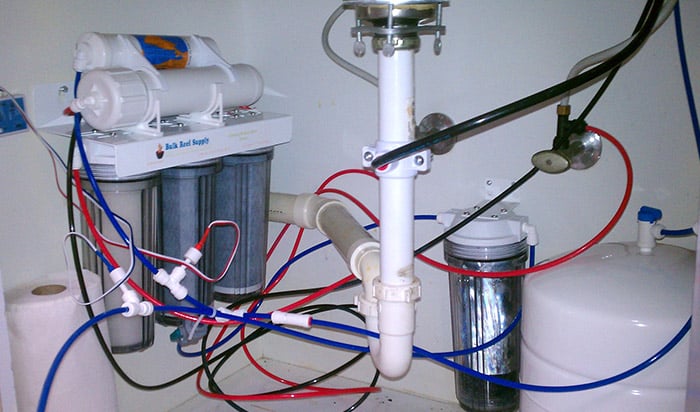It is pivotal for beginner aquarists and hobbyists to provide the essential equipment for a thriving reef aquarium. This refers to the requirements that make a strong and reliable life support system for the reef and all the inhabitants in your aquarium.
Proper lighting and temperature, sufficient tank size, and adequate water flow are some of the crucial elements that ensure a healthy aquatic life. More so the reef filtration systems that supply quality water for your reef, preserving healthy tanks without toxic contaminants, heavy metals, water hardness, algae growth, and other harmful minerals.
That said, it is imperative to install the best RODI System for reef tank setups (or Reverse Osmosis and Deionization filtration system) for this purpose.
In this article, National Park Aquarium will discuss the top reviews products for reef tanks and the guidelines to help you choose the ideal reef RO/DI systems for your aquarium.
Best Ro Di System for Reef Tank Reviews
1. LiquaGen Portable RO/DI Aquarium Reef Filter System
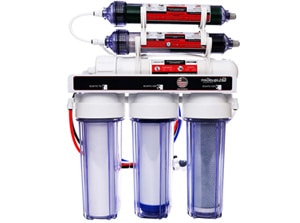
My first choice is LiquaGen RO/DI water system, featuring a Stage 6 filtration process. What fascinates me about this unit is the multifunctional outlet that works for reef tanks and filtering drinking water as well.
In terms of the filtration design, this 6-stage system highlights the sediment, GAC, and carbon block filter that filter out water from the garden house. Afterward, the water will go through the RO membrane, inline alkaline/carbon filter to deliver pH alkaline drinking water.
In addition to that, the final stage is the inline deionization that delivers 0 TDS water, suitable for reef tanks. Therefore, this filter system provides an optimal process not only for reef tanks but also for healthy drinking water.
As the filters remove any toxic contaminants and heavy metals usually present in water, it also works to restore essential minerals that usually get lost through the RO filtration process.
I know for sure that the unit amazingly works. I tried it before with our tap water, which measured 600 TDS (or ppms). That is surprisingly high and definitely not safe, especially for drinking water. However, we filtered out the tap water through this unit and it dropped from 600 to 0 TDS.
Setting up is also easy and can be done in about 5 to 10 minutes only. Moreover, I like that it includes a Manual Flush Valve to ensure the unit’s long-lasting quality.
This allows you to essentially flush the system and hence, prevent any possible leaks. I appreciate this design since it can save effort and cost for repairs in the long run.
I also want to highlight the capacity of this RO system, which is 150 gallons. Such a capacity is the most common RO DI system reef tank design for large aquariums.
My only issue is that there is no shut off or check valve available, which would have been useful for hassle-free use. However, I have learned that you can inform the seller about this so they would install it for you.
- 6-stage filtration process for clean and healthy water
- Multifunctional; Works great filtering water for reef tanks and as drinking water
- Includes a Manual Flush Valve to prevent leaks and prolong the unit’s quality
- 150 GPD or capacity
- Fast and easy installation
- Does not come with a shut off or check valve; the seller should be informed to have this installed
Overall, it is a reliable and multifunctional RO DI system – one of the most popular units out there. It ensures 0 TDS water suitable for reef tanks and optimal mineral restoration for healthy drinking water
2. Max Water Aquarium Reverse RO Filtration System
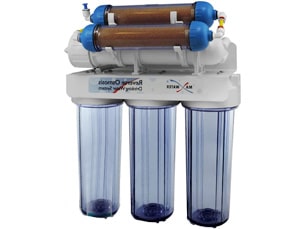
This Max Water RO/DI system is another great option for Stage 6 units. Comparing this to the LiquaGen, I can say that the features and the filtration process are almost the same. I think it all just comes down to the performance.
With regard to that, this RODI unit did great with the optimal water filtration for reef tanks. When I tested it on tap water, it delivered 0 TDS water, which is just perfect for reef tanks.
Similar to the LiquaGen, this system starts with the Micron Sediment filter, then Granular Activated Carbon (GAC) filter, and through the Micron Carbon Block in the third stage. The fourth stage is the RO membrane and the last stages (5th and 6th) are two inline mixed DI filters.
Take note that this unit has a capacity of 100 gallons, which I find the ideal for large reef tanks. Moreover, water pressure is the key to making this unit work well.
The manufacturer has indicated instructions regarding this, suggesting adding a booster pump when the water pressure is between 50 to 70 PSI or lower than 45 PSI. No need to worry about measuring the water pressure because a gauge is included in this unit for this purpose.
However, upon testing it on our water with pressure between 50 to 70 PSI without a booster pump, it actually worked fine. It fills up our aquarium tank easily and delivers 0 TDS water.
Moreover, this device comes with an automatic shut-off valve and a check valve, features the LiquaGen model doesn’t offer. These additions allow for smooth operation.
Unfortunately, it seems that some parts are missing, making installation harder than usual. It requires a supply adapter and some fittings, which were not included in the unit. You need to purchase them separately.
- 6-Stage RODI system for excellent water filtration
- Designed for reef aquariums and producing healthy drinking water
- Engineered with multiple filters to remove toxic contaminants
- Includes a water gauge to measure water pressure
- 100 GPD capacity
- Some parts need to be purchased separately
This is another excellent unit for aquarists looking for Stage 6 RODI systems for their reef tanks. Despite the minor issue with the installation, it works as expected, producing pure and fresh water for your reef tanks.
3. Koolermax AR-122 RO DI Reef Osmosis Water System

The best thing about this Koolermax 6-Stage is the hassle-free installation. All the tools, hardware, and tubings you need to set this up are all included in the unit. Not to mention a lower pricing mark compared to other 6 – Stage RO DI systems.
The on and off valve and a complete instruction manual are included as well. Therefore, I can say that this is the most suitable RODI system for reef tank aquariums for beginners and hobbyists.
When it comes to the purification process, all the stages or filters have been tried and tested, rendering an average rejection rate of 92 to 98% of dissolved solids. The system has the ability to eliminate microbiological contaminants and both organic and inorganic matter.
Just like the 6 – stage units I have tried, this RO system offers similar filters for optimal purification process: 1st stage is the micron polypropylene sediment filter, 2nd and 3rd stages are carbon filters, 4th stage is the TFC-150 RO membrane, while the 5th and 6th stages are DI filters.
This unit has a capacity of 120 GPD, which can supply water to multiple saltwater and freshwater tanks. I set it up before on small saltwater tanks and freshwater tanks, and this unit worked efficiently, producing zero TDS. Thus, it does what it is supposed to do.
Aside from that, it can deliver gallons nicely and fast. For 4 gallons, it took me around 30 to 40 minutes to fill up.
As mentioned, setting up is no trouble since every part or tool needed for the installation is included. It even has a mounting bracket, which is durable and convenient. I also like the addition of replacement fittings should the original pieces wear out eventually.
Moreover, changing the filters is also swift and easy. As you can tell, everything seems perfect with this unit. Perhaps, my only issue is that the filters are nonstandard and compatible only with Koolermax filters.
- Designed with multiple filters or 6 stages for a reliable water purification process
- Very easy to install; All tools and parts are included
- Effectively removes organic and inorganic matter as well as toxic contaminants
- Delivers absolute zero TDS
- 120 GPD capacity
- The filters are not standard; Should only be replaced with Koolermax filters
Nonetheless, this RODI water system works as expected whether you use freshwater or saltwater reef tanks. It is easy to install and use, making it a great unit for beginner aquarists and hobbyists.
4. Premier Osmosis RODI Water Filtration System

For large saltwater and freshwater reef tanks, the Premier Water Systems RO/DI unit is another excellent option that does the job effectively. Although this is a 5 – stage RO/DI system, it is not inferior to other units available on the market.
Amazingly, this system can eliminate up to 99% total of dissolved solids (TDS), ensuring ultra-pure water needed for reef tanks. As mentioned, this unit has five filter stages for optimal purification.
The first stage uses a Polypropylene Sediment, which you can tell is the same as the 1st filters of the aforementioned 6 – stage RO systems. Its role is to remove sand particles, dust, dirt, and chemical resistance.
The second stage is the UDF Activated carbon filter that is responsible for eliminating tastes, odors, organic matter, and many other impurities usually present in tap water.
The third stage almost has the same filter function where the coconut carbon works to get rid of organic matter and other water impurities.
Then, as the water goes through this phase, it will find its way to the RO membrane, which is the fourth stage and primarily functions to remove contaminants like lead, arsenic, and more.
The DI or Deionization cartridge is in the final stage and does the job to eradicate almost all toxic minerals, producing healthy, pure, and clean water for the reef tanks.
For a 5 – stage RODI system, this unit is quite a steal. The process might sound complex but it actually does the job seamlessly. I find it really easy to use and hence, I recommend it to newbie aquarium keepers and hobbyists.
Furthermore, it is portable and compact so setting up is not a problem. The tools, tubing, and all necessary connections are included in this unit. And since it has a capacity of 150 GPD, it is an ideal design for large reef tanks and multiple aquariums.
I honestly cannot find any faults in this RO unit. I guess the only thing to watch out for is the water pressure. The ideal level should be about 65 PSI to be able to achieve 150 GPD. In that case, you may consider getting a water gauge to determine the pressure.
- Engineered with 5 stages for easy and efficient water filtration
- Designed with premium quality filters that eliminate harmful chemicals, minerals, and other organic and inorganic matter
- Very easy to set up and use; All parts, connections, and tubings are included
- 150 GPD capacity
- Ideal for beginner aquarists and hobbyists
- The water pressure needs to be checked to be able to go up around 150 GPD
This 5-Stage RO/DI System for reef tanks is a great value for money. It is extremely easy to use and set up, making it an excellent option for beginner aquarium keepers and hobbyists. Moreover, it does what every RODI system is supposed to do – to eliminate impurities and provide ultra-pure water.
5. AquaFX Barracuda RO/DI Aquarium Filters
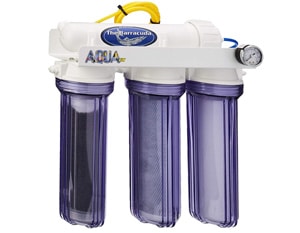
The AquaFX Barracuda aquarium RO/DI filter is the unit I recommend for small reef tanks since they do not usually require hefty gallons of water every day. This 4 – stage RODI system features a capacity of 50 GPD.
Sifting through its design, this system has four filters or stages that can block and remove tap water impurities. Although this unit has the least filter count compared to the rest on our list, it does an efficient job to provide absolute 0 TDS.
These filters include two-micron chlorine guzzler carbon block filters that effectively remove chlorine and reduce a lot of toxic contaminants present in the water. That also includes volatile organic compounds (VOC) such as lead, fluoride, and more.
I tested it on our tap water which measured 400 TDS. Then, I had our water run through these filters and it registered 0 TDS afterward. I was quite impressed by its performance, considering the unit’s capacity.
What I also like about this unit is the ease of use. It comes pre-assembled with only a little elbow grease required when connecting the tubings. Once connected, you are all set to purify the water for your reef tank.
Aside from that, it comes in a portable size, which I find suitable for compact spaces. Moreover, this unit is very affordable, which is a good choice for hobbyists and beginner aquarium keepers.
Just a heads-up, this unit functions a bit slowly. If you want to fill a gallon of water, you would have to wait around 15 to 20 minutes. It could be a big deal for some aquarists but I think it is nothing compared to the excellent output you can get from it.
One more thing I would want to have in this unit is a TDS meter. It is not included in the unit although you can purchase it separately for a very cheap price.
- A 4 – stage RO/DI system suitable for small reef tanks
- Designed with chlorine guzzler carbon filters that remove chlorine and other water impurities
- Effectively removes VOCs or volatile organic compounds to produce clean and pure water
- Very easy to set up and use
- 50 GPD capacity
- TDS meter not included
- The filtration process is a bit slow
Nevertheless, this is a great starting RO reef tank unit for beginner aquarists and hobbyists. Besides the affordable price and portable size, this 4 – stage system delivers an impressive output that can match the more expensive units.
How to Choose RODI Systems for Reef Tanks
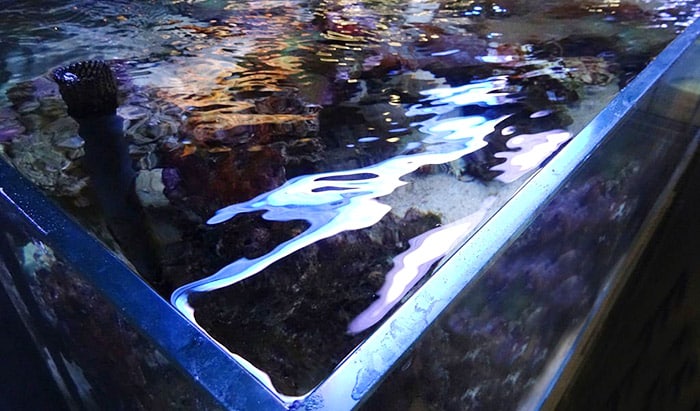
1. Filtration Process or Stages
RO/DI systems vary in filtration processes or stages, ranging from Stage 4 to Stage 7. Keep in mind that ordinary tap water is not recommended for a reef tank due to the traces of chlorine and other chemicals that are extremely toxic to the fish and coral.
That said, these stages filter out and eliminate these toxins and harmful chemicals, ensuring healthy and quality water and habitat for the reef. 4 – Stage RO or RODI for reef tank setups is the most affordable and portable among all the systems but still produces the ideal TDS (Total Dissolved Solids), which is zero.
Take note that whichever filtration process you choose, the goal is to achieve a 0 TDS level. This water parameter level indicates that the unit can dissolve any toxic contaminants and other elements, including chlorine, phosphates, and heavy metals that can kill your fish and reef as well as cause issues in your tank in the long run.
Typically, more stages mean a higher pricing point. However, these additional stages can provide better filtration, including carbon filters and deionization filters. You may consider the following comparison:
4 – STAGE: It features filters that remove chlorine and other common water contaminants to provide a 0 TDS level. Very affordable, popular among aquarists, and ideal for beginner aquarists and hobbyists.
5 – STAGE: It features an additional carbon filter that provides enhanced protection against toxic contaminants, including chlorine and chloramines. Ideal for most aquariums.
6 – STAGE: It has similar features as the Stage 5 unit but is added with two DI (Deionization) filters. Great for large reef aquariums or multiple tanks that require hefty gallons of fresh water every day.
7 – STAGE: It highlights the addition of two carbon filters and multiple DI filters that provide optimal water filtration for large or multiple large tanks. The most expensive RO/DI unit.
2. Size and Capacity
The size of RODI systems is typically measured by GPD or Gallons Per Day. This factor depends entirely on the size of your tank. The larger the tank, the higher GPD you need. Otherwise, you may have to refill more frequently. Therefore, it is imperative to determine how many gallons you need for your aquarium per day.
3. Installation
Easy installation is a must to make sure these units work effectively and accordingly, especially when you have large or multiple tanks that require higher filtration stages. Fortunately, most RO/DI systems are pre-assembled and usually take around 5 to 10 minutes to set up.
4. Multifunctional Outlets
Many RO/DI units are designed to function as water filters as well. Therefore, these units feature one outlet for the reef tank and another for drinking water.
Conclusion
In a nutshell, setting up the best RODI System for reef tank aquariums is crucial for aquatic life. These units provide fresh and healthy water to help the fish and reef thrive, eliminating any toxins and other harmful minerals that are commonly present in ordinary tap water.
Luckily, these RO/DI systems for reef tanks are widely available for both aquarium keepers and hobbyists alike. Since these systems vary in size and filtration stages, the key is to determine the aquarium tank size, allowing you to identify how much RO water your tank needs. Consider the reviews and adhere to the aforementioned guidelines to help you find your unit for your reef tank.

